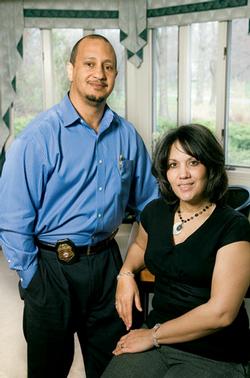
The heat that overcame firefighter Joe Morgan had come up from the basement of a townhouse in Northeast DC. He was inside for three minutes, following the thick smoke, before he had to crawl out. He would later learn it was 1,500 degrees in the first-floor living room where he’d been kneeling that night in May 1999.
Morgan had second- and third-degree burns over 65 percent of his body. Two other firefighters, including his partner, died. Firefighters didn’t know at the time that the owners of the house had gotten out safely before they arrived.
Doctors at Washington Hospital Center gave the 35-year-old father a 5-percent chance of survival. They performed skin grafts on his thighs first, where the burns were the worst, using donated skin.
“The skin really sustained me,” says Morgan, who spent 2½ months in the hospital and underwent 30 surgeries over two years. “It kept me alive.”
While only 1 to 2 percent of area deaths met the criteria for organ donation last year, about 20 percent of those who died in the Washington area had tissue suitable for donation. One tissue donor can help more than 50 people: Skin, cartilage, heart valves, and other tissue can be recovered. Donated bone can help patients with cancer; ligaments and tendons can be used for knee repairs and other injuries. Jennifer Porter, a lawyer who lives in Fairfax County, received donated corneas for a transplant that saved her vision. During one of her eye surgeries, doctors used part of a donor’s pericardium, a membrane sac surrounding the heart.
“You wouldn’t think this tiny piece of pericardium would have any use to anybody,” Porter says. “It solved a serious medical problem for me.”
People who sign up to be organ donors—when getting or renewing a driver’s license or through an online registry—are automatically potential tissue donors. More than 2,500 people who died in Washington last year could have been tissue donors. Of those, 359 actually donated.
Why the gap? Many families don’t authorize tissue donation in time. The Washington Regional Transplant Community contacts potential donor families by phone—conversations about organs happen in person—and sometimes loved ones have just left the hospital and the call goes unanswered. Other times, families are too grief-stricken to talk about donating.
“Many folks do not know about the life-enhancing aspects of tissue gifts,” says Cindy Speas of the WRTC. “That’s the main reason there’s a low rate.”
While some people are too young or old for tissue donation, illness doesn’t necessarily rule out a donor. People with heart disease, osteoporosis, and other non-transmittable conditions—the Food and Drug Administration has strict regulations to prevent disease transmission—can donate most tissue. Some cancer patients can donate; others can’t. Almost everyone can donate corneas.
“It makes such a difference,” says Joe Morgan, now an assistant fire marshal at the National Institutes of Health. “It saved my life.”
To register as an organ and tissue donor, visit beadonor.org.
This article first appeared in the May 2009 issue of The Washingtonian. For more articles from that issue, click here.

















